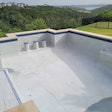
In the very loose and very edited words of William Shakespeare:
“To charge, or not to charge, that is the question:
Whether ’tis nobler in the mind to offer your designs for a fee and reap the rewards immediate,
Or to give them away,
And quicken the way to the sale...”
And thus, the debate over pool and landscape design begins: Should you charge for your design work?
My entire pool career started with GENESIS 13 years ago. Little did I know this educational program would change my life. Back in the day, to become a Pool & Hot Tub Alliance (PHTA) Certified Master Pool Builder & Design Professional (Master CBP), I had to physically fly to many destinations, take eight to 16 hours of classes over the course of two to three days, sometimes three times a year. Today, with the increased availability of on-demand and virtual education, this elite designation is more accessible to more pool professionals — and valuable to you and your company in more ways than one.
However, achieving this level of education can be expensive. So when you are an educated professional, you charge for your services. Interior designers charge, landscape architects charge, architects charge — it’s just the way things work. Why is it that in the pool business we don’t charge for our designs? (I should say, most of us don’t charge for our designs.)
Let’s explore the pros and cons of both sides of this discussion, and you can decide which camp you fall into. At the very end, I will tell you where I land!
TOP 10 REASONS TO CHARGE FOR DESIGN
1. It’s a Standalone Service
The design itself is often valuable — even if the client doesn’t move forward with the build. It includes site planning, grading, drainage, and aesthetic layout. Depending on the property, there may be restrictions that cover protected items like trees, rivers, lakes, or bio-sensitive areas. Frost and freeze protection, easements, or other issues need to be understood before a precise and notated drawing can be completed.
2. Discourages Tire-Kickers
Charging filters out clients who aren’t serious or are just shopping around for ideas. If you’re trying to weed out clients with smaller budgets than you’re able or willing to serve, charging for design may help you focus on higher-end clients.
3. Protects Intellectual Property
Free designs can be handed off to a cheaper contractor. Charging helps deter this, or at least covers your costs if the client decides to go elsewhere for the build. (Even a paid design can be farmed out for quotes. I’ve received many competitors’ basic plans from prospects who were shopping and, with some minor tweaks, sold the project.)
4. Compensates for Time and Site Visits
On-site consultations, measurements, and revisions can take hours. Charging offsets that effort.
5. Professionalism and Positioning
Charging positions the designer as a high-end, full-service provider — not just a contractor.
6. Builds Client Commitment Early
When clients pay for design, they’re more likely to follow through on the project. They feel obligated to move forward if they love the design and love you. (If they love the design and not you, however, they’re going shopping!)
7. Licensing and Regulations
Some jurisdictions require licensed professionals for certain aspects of the design (grading, irrigation, etc.), which justifies fees.
8. Custom, High-Value Deliverables
Many firms offer 3D renders, video flythroughs, lighting plans, and planting schedules — all billable assets. You pay good money for this software and the training to use it. You need to reimburse those costs.
9. Better Budget Alignment
Paid design sessions often include budgeting guidance to align the client’s vision with reality.
10. Separation of Services
Charging allows you to offer design as a standalone service for clients who want to build in phases or with someone else.
10b. By charging for designs and delivering high-quality work from your designs, you can really start to brand yourself as a top-tier designer. Eventually, people will ask for you by name.
TOP 10 REASONS TO NOT CHARGE FOR DESIGN
1. It’s Included in Build Quote
Some pool companies bundle the design cost into the construction estimate (and only charge if the client walks away).
2. Sales Strategy
Free design is used to win the job, especially in competitive markets where others also offer it for free. This can increase your closing rate, but you’ll still lose quite a few jobs to competitors because clients didn’t pay for it, and thus they see no value in it, and therefore, they don’t feel guilty shopping it around.
3. Basic Sketches vs Full Plans
Some only offer rough concepts for free, reserving detailed drawings for paying clients. You should still make sure your drawings are correct and to scale, even if they are not labeled so.
4. Perception of Value
Some clients don’t expect to pay for design — so firms offer it free to avoid friction. I find this client usually is not serious or has a smaller budget.
5. Volume Business Model
High-volume installers may treat design as a minor lead-generation cost, offset by frequent builds.
6. It’s a Loss Leader
Free designs can attract more clients into the pipeline, assuming a percentage will convert.
7. Low Differentiation
In some markets, everyone offers free design — so charging may seem like
a competitive disadvantage. In many cases, designers don’t even know who charges and who doesn’t; they are only assuming and, therefore, may be selling themselves short.
8. Design In-House by Sales Team
Some companies have salespeople use design software like Pool Studio or SketchUp to generate quick visuals with minimal cost.
9. Minimalist Design Needs
Basic yards or pool shapes may not require in-depth design — especially for pre-fab or cookie-cutter installs. I would argue that you still need to understand the property, rules, and restrictions. But if you are only doing the pool, you may get away with a basic free drawing that suits the needs of the project.
10. Closing Leverage
Some designers offer “free design with a signed contract” to push clients toward making a deal. This is a great way to get the pool sold and work on the rest of the project, including the landscaping, lighting, irrigation, hardscape, and softscape.
PERSONAL PREFERENCE
I fall somewhere between the two.
When I first go to the client, they almost always get a quick hand sketch to understand my thoughts on what can fit in their backyard after we’ve discussed their wish list. This is for free. I even let them take a picture of it. No one is going to quote from that, I promise you!
When I decide what budget level the client is, then I have my internal “to charge or not to charge” debate. To be clear, I believe I should be charging something for every design I do (after the hand sketch). I’m worth it.
I leave you with a few tips:
If you’re not going to charge for a design, call it a “concept” only. Put no measurements on it, not even the pool. Make sure it is to scale, though, so when they do move forward you don’t have to remeasure.
If you are charging for design, manage the clients’ expectations up front. Be very clear what’s included and what’s not. Have prices ready for the things that are not included.
Make sure you are very clear how many major and minor edits are allowed. For a free design, that number is zero until they at least buy the pool.
So: To charge or not to charge for design? That’s the real question. It comes down to how you position your brand, manage your pipeline, and value your time. I’d love to hear where you land on the debate!
This article first appeared in the August 2025 issue of AQUA Magazine — the top resource for retailers, builders and service pros in the pool and spa industry. Subscriptions to the print magazine are free to all industry professionals. Click here to subscribe.











































